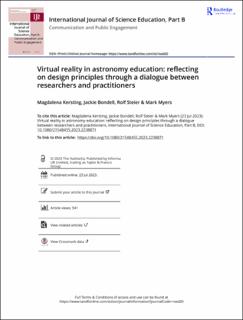Virtual reality in astronomy education: reflecting on design principles through a dialogue between researchers and practitioners
Peer reviewed, Journal article
Published version
Permanent lenke
https://hdl.handle.net/11250/3096641Utgivelsesdato
2023Metadata
Vis full innførselSamlinger
Originalversjon
International Journal of Science Education, Part B: Communication and Public Engagement (IJSE). 2023, . 10.1080/21548455.2023.2238871Sammendrag
Virtual reality (VR) technologies have the potential to transform
astronomy education practices profoundly: new forms of visual
representations, perceptual engagement and embodied participation
promise authentic learning experiences in formal and informal learning
spaces. While a growing body of research studies the educational needs
and opportunities of VR astronomy education from the learner’s
perspective, relatively few studies have explored the perspectives of
education and public outreach (EPO) professionals. This study aims to
turn our attention to these complementary perspectives and shed light
on design considerations for using VR in astronomy education. We
unpack design principles as a dialogue between researchers and
practitioners, framing this dialogue as an act of reflective practice. The
findings and the ensuing dialogue draw on data from two focus group
interviews with EPO professionals and scientists from the Australian
Research Council Centre of Excellence for Gravitational Wave Discovery.
Our design principles centre on aspects of immersion, visualisation,
facilitation, and collaboration and can guide astronomy educators who
wish to use VR in formal and informal learning environments. Besides,
our study contributes to a deeper understanding of the new learning
contexts VR technologies can create in astronomy education.

